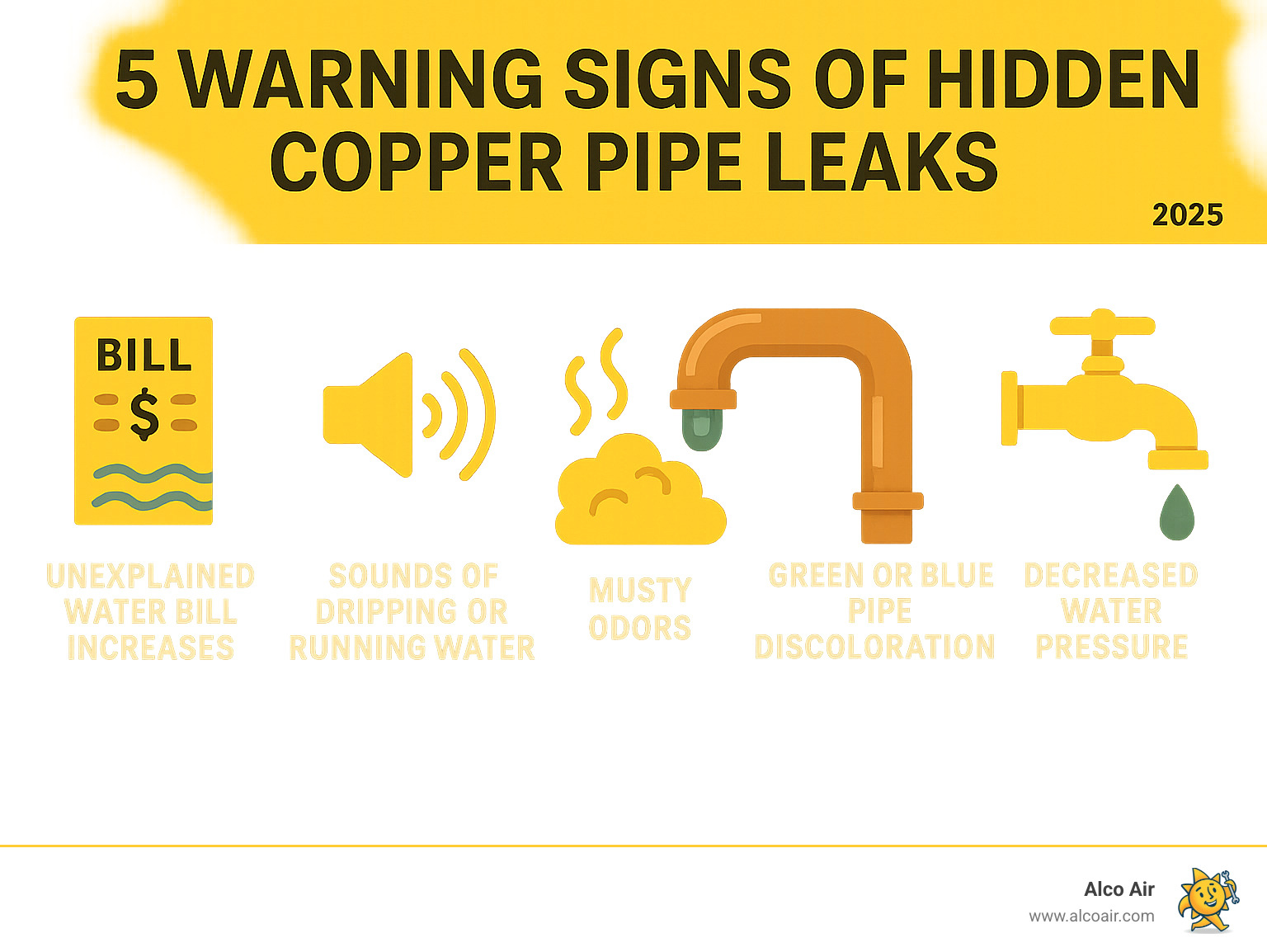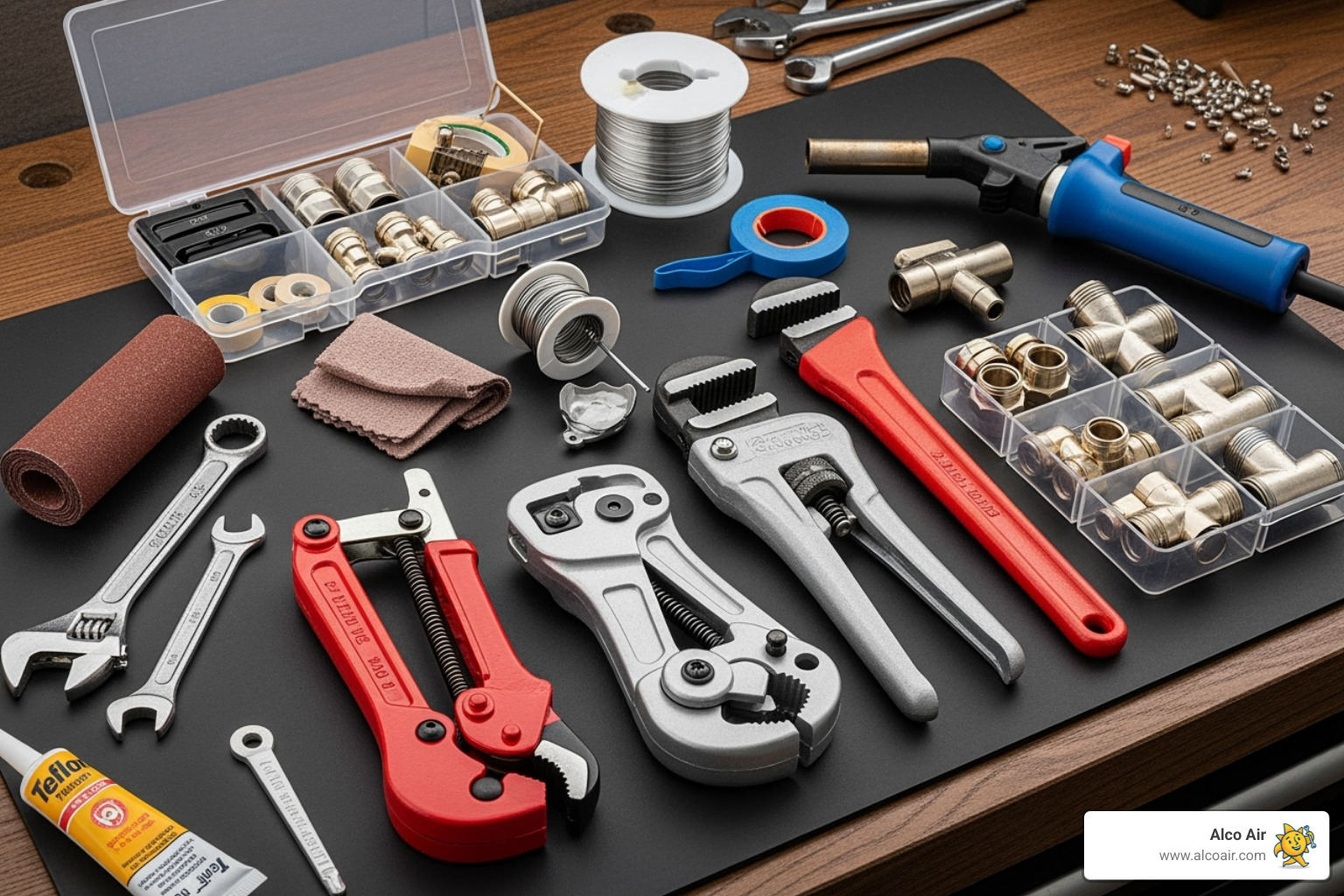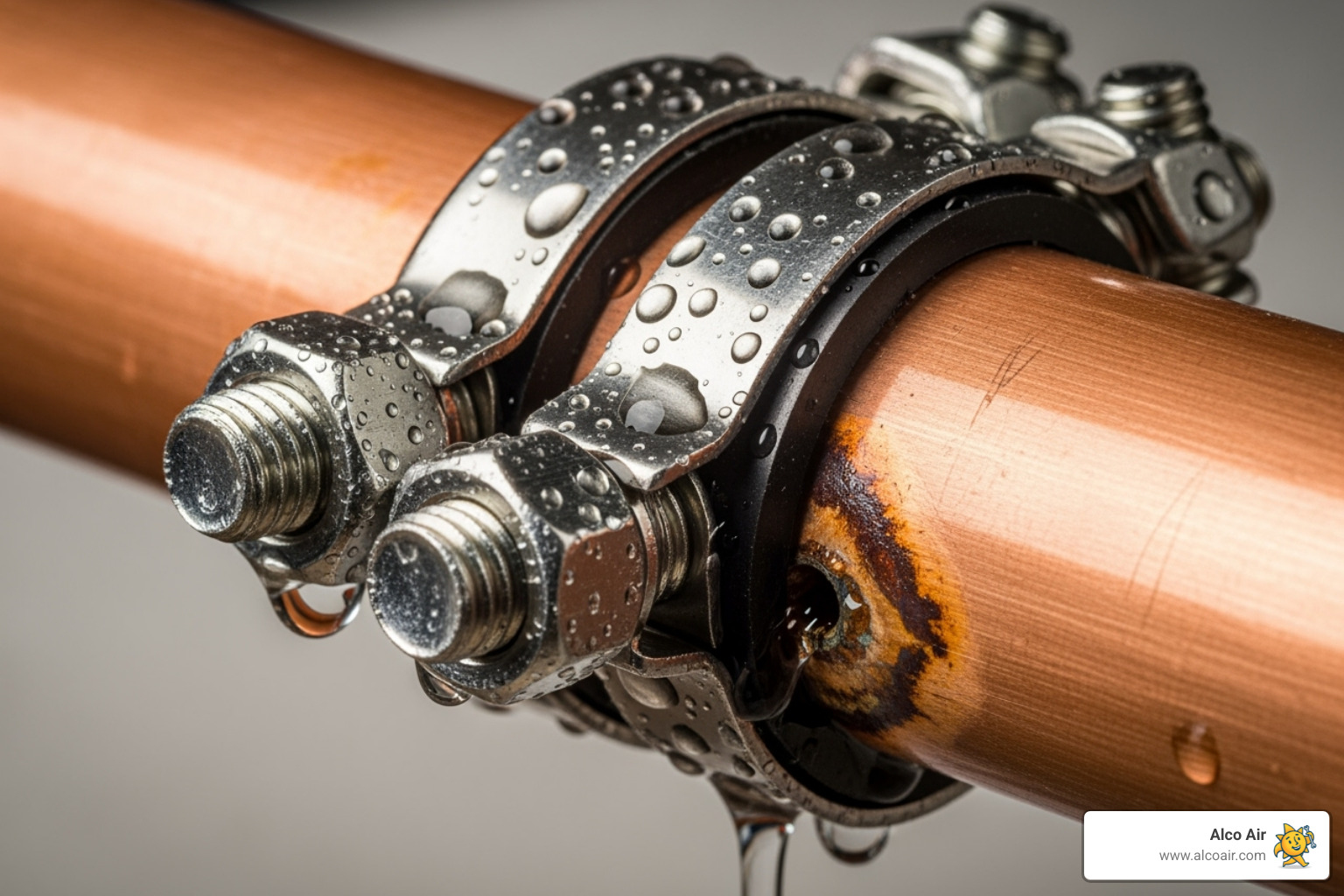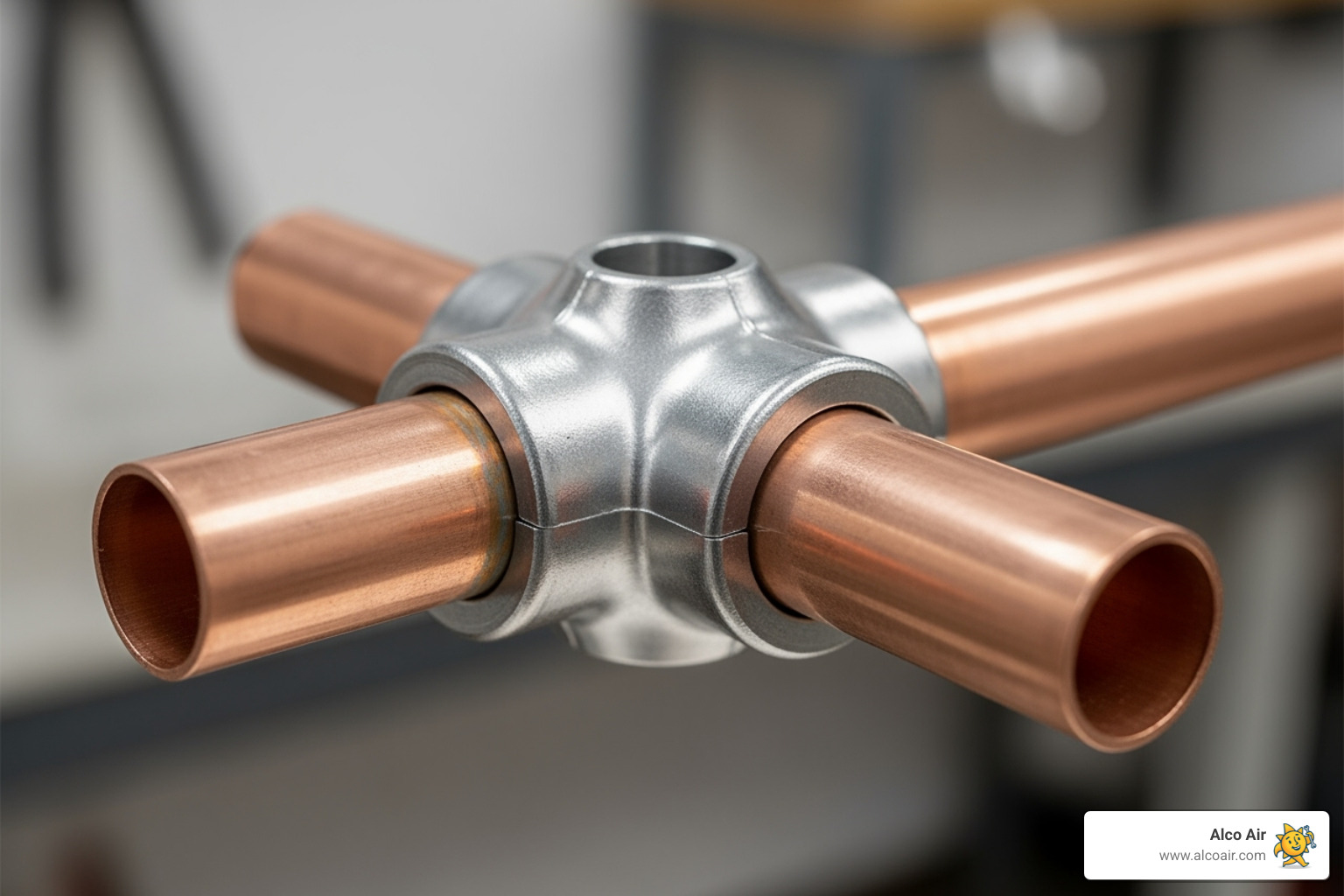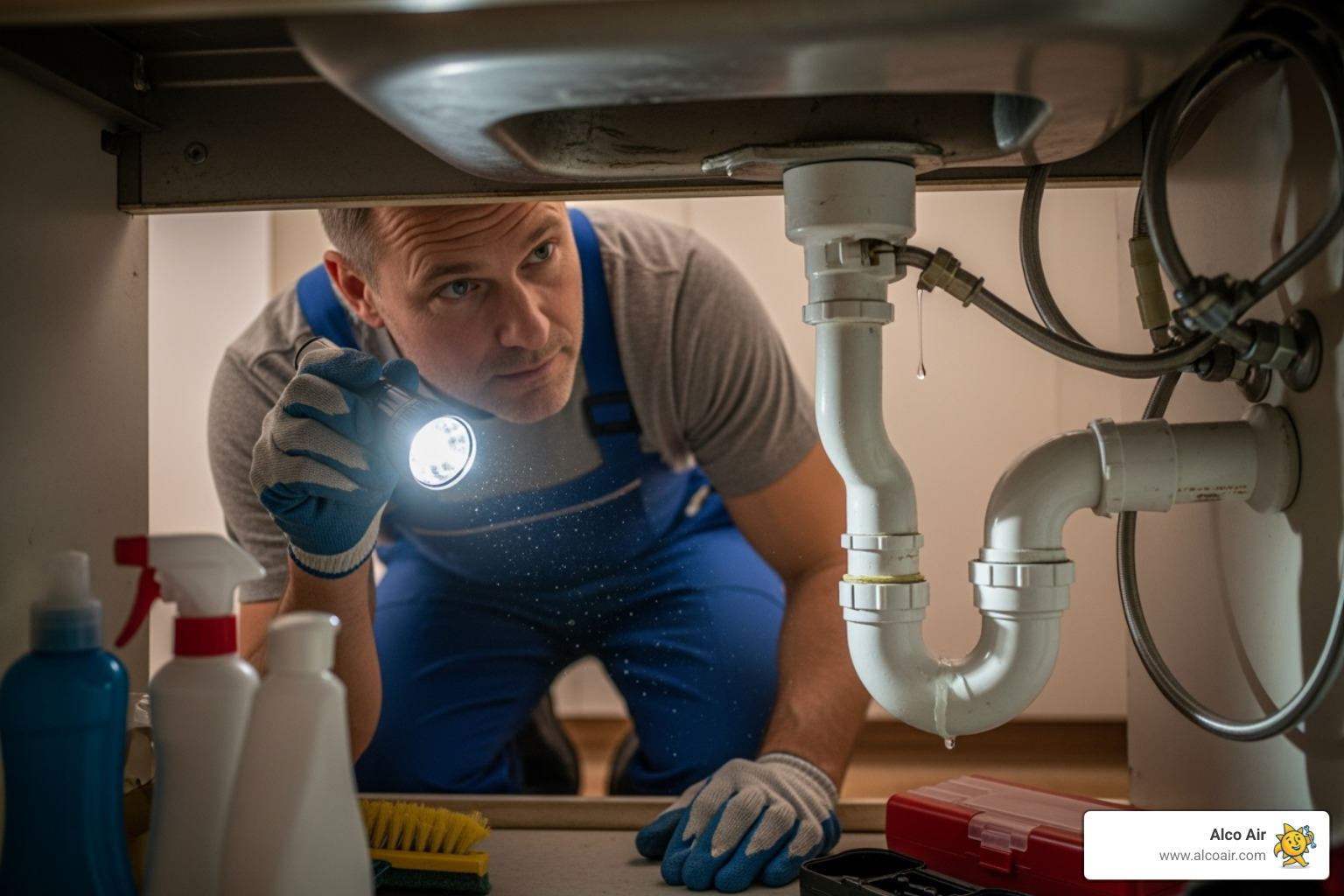Why Quick Action Saves You Money and Headaches
Copper pipe repair becomes urgent the moment you hear a dreaded dripping sound or notice your water bill climbing. A frantic text about a ceiling leak is a scenario that plays out in countless homes across Longview, TX.
Quick Answer: How to Fix a Copper Pipe Leak
- Turn off the water at the main valve or local shutoff
- Drain the pipes by opening nearby faucets
- Choose your repair method:
- Temporary: Pipe repair clamp, epoxy putty, or rubber gasket with hose clamp
- Permanent: Cut out damaged section and install new pipe with push-to-connect fittings or soldering
- Test the repair by slowly turning water back on
- Call a professional if you see multiple leaks or feel unsure
The good news is that many leaks can be fixed without an emergency call, if you know what you’re doing. Quick action is key to preventing a minor leak from becoming a major water damage disaster.
Whether you’re dealing with a pinhole leak or a joint failure, understanding your options helps you choose between a temporary fix and a permanent solution.
Understanding the Problem: Signs, Causes, and Pipe Types
Understanding the warning signs of a pipe problem can mean the difference between a quick copper pipe repair and a major water damage disaster.
What are the common causes of copper pipe leaks?
Copper pipes can last up to 70 years, but certain conditions can cause them to fail.
Pinhole leaks are sneaky troublemakers caused by pitting corrosion. This happens when water chemistry, like mineral-heavy hard water or high pH levels, corrodes the pipe from the inside.
High water pressure strains your plumbing system. Even worse is water hammer—the banging sound from a quickly closed faucet—which sends shockwaves that weaken pipe joints and create leaks. High pressure (the force of the water) makes leaks worse, while flow rate is the amount of water moving through the pipes.
Poor installation, such as bad soldering or nicks made during construction, can also create weak spots that eventually fail.
What are the signs that indicate a copper pipe needs repair?
Your home will give you hints that something is wrong. The trick is to pay attention.
- A mysterious dripping sound often indicates a hidden leak behind a wall or under a floor.
- Musty smells are a red flag for hidden moisture and potential mold growth, often caused by a leak.
- A sudden spike in your water bills without a change in usage almost always points to a leak.
- Look for pipe discoloration. Green or blue streaks on copper pipes indicate oxidation and a potential leak.
- High water bills and low water pressure are a classic sign of a significant leak in your system.
How can I identify the type of copper pipe I have?
The Type K, L, and M differences matter for repairs, as fittings must match the pipe.
- Type L (blue stripes) is the most common for residential water supplies.
- Type K (green stripes) is a heavy-duty pipe used for main water lines.
- Type M (red stripes) is thinner and often used for heating systems.
These markings are stamped on the pipe. Knowing your pipe type ensures you use the right materials for your copper pipe repair.
If you’re dealing with multiple mystery leaks or can’t pinpoint the source, our experienced team can help. More info about our leak detection services is available on our website – because sometimes the best DIY decision is knowing when to call in the professionals.
Your Toolkit: Essential Tools and Safety for DIY Repair
Ready to tackle that copper pipe repair yourself? Fixing a problem with your own hands can be satisfying and saves you from waiting for a plumber while water is dripping.
But first, safety. Skipping safety steps can turn a simple repair into a major headache, especially since water and electricity are a dangerous mix.
Safety First!
Take these precautions seriously to prevent a small leak from becoming a disaster.
- Turn off the water supply: This is your first move. Locate the main shut-off valve (often in a basement, utility room, or outside) and turn it off.
- Drain the line: Open the lowest faucet in the house and any near the repair. This releases pressure and prevents a gush of water when you cut the pipe.
- Electrical safety: If the leak is near outlets or fixtures, turn off power to the area at the electrical panel.
- Protective gloves: Use nitrile or latex gloves to protect your hands, especially when handling epoxy or old pipes.
Your Essential Tools for Copper Pipe Repair
Having the right tools makes copper pipe repair manageable. These essentials will set you up for success.
- A pipe cutter makes clean, square cuts essential for a good seal.
- Emery cloth or fine sandpaper cleans the outside of the pipe before attaching fittings.
- A deburring tool, often part of the pipe cutter, smooths the inside edge after a cut to prevent weak spots.
For permanent repairs, a propane torch with lead-free solder and flux creates the strongest bond. For solder-free options, push-to-connect fittings simply push on to lock in place, while compression fittings use nuts and rings to create a seal.
For emergencies, pipe repair clamps or epoxy putty can provide a quick, temporary fix.
Don’t forget a measuring tape, a marker, and buckets or rags to catch residual water in the pipes.
If you’re leaning toward avoiding the torch altogether, there’s an excellent resource that walks through your options: A guide to solder-free repairs.
Your Step-by-Step Guide to Copper Pipe Repair
Fixing the leak requires choosing between a quick, temporary fix to stop immediate damage and a permanent, long-term repair. Temporary fixes are not permanent solutions. They are an emergency response to stop a leak, not a long-term repair.
| Method Type | Cost | Durability | Skill Level | Code-Approval |
|---|---|---|---|---|
| Temporary Fixes | Low | Short-term (days-weeks) | Easy | Generally No |
| Push-to-Connect | Medium | Long-term (years) | Easy-Medium | Yes (most areas) |
| Compression | Medium | Long-term (years) | Medium | Yes (most areas) |
| Soldering | Medium | Permanent (decades) | High | Yes |
Long-term implications of temporary fixes
While a temporary fix can stop an immediate crisis, it’s not designed to be permanent. The materials fight a losing battle against water pressure and can degrade, shift, or lose their seal over time. Most temporary fixes are not code-approved, which can cause problems during home inspections or with insurance claims if the fix fails. A temporary patch also masks the underlying problem, such as widespread corrosion, which can continue to spread.
Temporary Fixes for Emergencies
When you have an active leak, these emergency methods can buy you time to plan a proper copper pipe repair.
- Pipe repair clamps: After turning off the water and draining the line, clean the pipe and position the clamp’s rubber gasket over the leak. Place both halves of the clamp around the pipe and tighten the screws evenly until the leak stops. Do not over-tighten.
- Epoxy repair putty: Ideal for pinhole leaks. After shutting off the water and draining the pipe, sand the area around the leak and ensure it is clean and dry. Knead a piece of putty until it’s a uniform color. Press it firmly over the leak, extending about an inch in all directions. Allow it to cure for at least an hour before testing.
- Rubber gasket with hose clamp: An improvised fix. Wrap a piece of rubber tightly around the leak and secure it with a hose clamp, tightening until the dripping stops.
These emergency fixes buy you time. For guidance on next steps, check out our resource: What to do in a plumbing emergency.
Permanent Copper Pipe Repair: The Long-Term Solution
A permanent repair requires removing the damaged section and replacing it. This is a manageable DIY project for many.
- Push-to-connect fittings: A great DIY option for copper pipe repair as they require no soldering. After shutting off the water, cut out the damaged section. Use a deburring tool on the inside edges and polish the outside of the pipe ends with emery cloth. Measure the gap, cut a new piece of pipe to fit, and push the fittings firmly onto the pipe ends. Then, insert the new pipe section into the fittings.
- Compression fittings: Another solder-free option. Prepare the pipes, then slide the nut and ring onto each end. Insert the pipes into the fitting, hand-tighten the nuts, and then use two wrenches to snug them. Do not over-tighten.
- Soldering: The gold standard for permanent repairs but requires more skill. After cutting and cleaning the pipes, apply a thin layer of flux to the pipe ends and the inside of the coupling. Heat the joint with a propane torch. Touch lead-free solder to the joint opposite the flame; it should flow smoothly into the gap. Once the joint is filled, remove the heat and wipe away excess flux.
Testing the Repair
To test the repair, slowly turn the water back on. Gradually reopening the main valve prevents shocking the new connection. Carefully inspect your work for any drips. Once the system is repressurized, open nearby faucets to purge any trapped air. Monitor the repair over the next few hours for any signs of a leak.
When to Call a Professional Plumber
While many copper pipe repair projects are DIY-friendly, it’s smart to recognize when a job requires a professional.
At Alco Air, our NATE-certified technicians have over 30 years of experience diagnosing mysterious leaks and preventing plumbing disasters. Call a professional for these issues:
- Widespread or multiple pinhole leaks: This often signals system-wide corrosion. Fixing individual spots won’t solve the larger problem, which may require a whole-house repipe.
- Slab leaks: Leaks under your home’s foundation are not a DIY project. They can cause significant structural damage and require specialized equipment to detect and repair.
- Low water pressure issues: If pressure is low throughout your home, it can indicate serious pipe deterioration or a problem with the main water line that requires professional diagnosis.
- Soldering in tight spaces: This is a fire hazard, especially near flammable materials. Professionals have the right tools and experience to work safely.
- If you’re unsure or uncomfortable: It’s best to stop. A botched DIY copper pipe repair can cause major water damage and cost more than hiring a professional initially.
- Major water damage: If a leak has already damaged drywall, flooring, or electrical systems, you need professional help for both the plumbing and the restoration.
- Persistent issues: A recurring leak after a repair signals an underlying problem that needs a professional diagnosis.
Our team doesn’t just patch the problem; we find the root cause. We’re skilled at Repairing Hidden Plumbing Leaks and ensuring your system is sound.
With our 4.8-star Google rating and 100% money-back guarantee, you’re not just getting a repair – you’re getting peace of mind.
Frequently Asked Questions about Copper Pipe Leaks
After three decades of copper pipe repair in Longview, TX, we’ve heard every question. Here are the most common ones.
How long do copper pipes typically last?
Copper pipes are workhorses and can last up to 70 years. However, that lifespan isn’t guaranteed and depends on several factors.
- Water quality is the biggest factor. Aggressive water (acidic or alkaline) or hard water with high mineral content can accelerate corrosion.
- Installation quality also matters. Poorly soldered joints or nicks in the pipe can lead to premature failure. Our NATE-certified technicians ensure every connection is done right.
Can I use a temporary fix, like a clamp, permanently?
It’s tempting to leave a temporary fix in place permanently, but this is a bad idea.
- Temporary fixes are not code-approved for permanent use. This can cause issues during a home sale or with an insurance claim, as inspectors will flag them.
- These materials are not designed for long-term exposure to water pressure and time. Gaskets dry out, epoxy cracks, and clamps can shift or corrode, leading to failure.
- Insurance companies may deny a claim for water damage if it’s caused by the failure of an improper, temporary repair.
Think of temporary fixes as buying you time to schedule a proper copper pipe repair, not as the final solution.
What causes the small, pinhole leaks in my copper pipes?
Pinhole leaks are a warning sign of a larger problem. They are almost always caused by pitting corrosion, which eats away at the pipe from the inside.
- Water chemistry is the usual culprit. Hard water minerals can build up as scale inside pipes, creating spots where corrosion can take hold.
- A pH imbalance is also a problem. Water that is too acidic or too alkaline can cause damaging chemical reactions with the copper.
- High water velocity can also cause wear. Fast-moving water can strip away the protective oxide layer inside the pipe, exposing the raw copper to corrosion.
The concern is that a pinhole leak in one area suggests the same corrosive conditions may exist throughout your entire plumbing system. That’s why our team takes a comprehensive approach to diagnose the root cause and prevent future problems.
Your Next Steps for a Leak-Free Home
You now have the knowledge to make smart decisions about copper pipe repair, from pinhole leaks to more significant pipe failures. Finding a leak is stressful, but you’re not helpless. With the right information, you can handle minor repairs yourself and know when to call for professional help.
Prompt action is crucial. A small drip can quickly lead to thousands of dollars in water damage if it’s ignored. Temporary fixes are not permanent solutions. They are designed to buy you time to arrange for a proper, long-term repair.
This is where Alco Air’s expertise helps. With over 30 years of experience in Longview, TX, our NATE-certified technicians have handled everything from pinhole leaks to slab leaks. Our 4.8-star Google rating reflects decades of customer trust.
Knowing when a job is beyond your comfort zone is key. If you see multiple leaks, experience a drop in water pressure, or have a repair that keeps failing, it’s time to call professionals for a lasting solution.
Your plumbing system works hard every day. Don’t let a small leak become a major headache.
Ready to ensure your pipes are in expert hands? Schedule your professional plumbing repair in the Omaha, TX area today! Our team is standing by to help you achieve that leak-free home you deserve.


